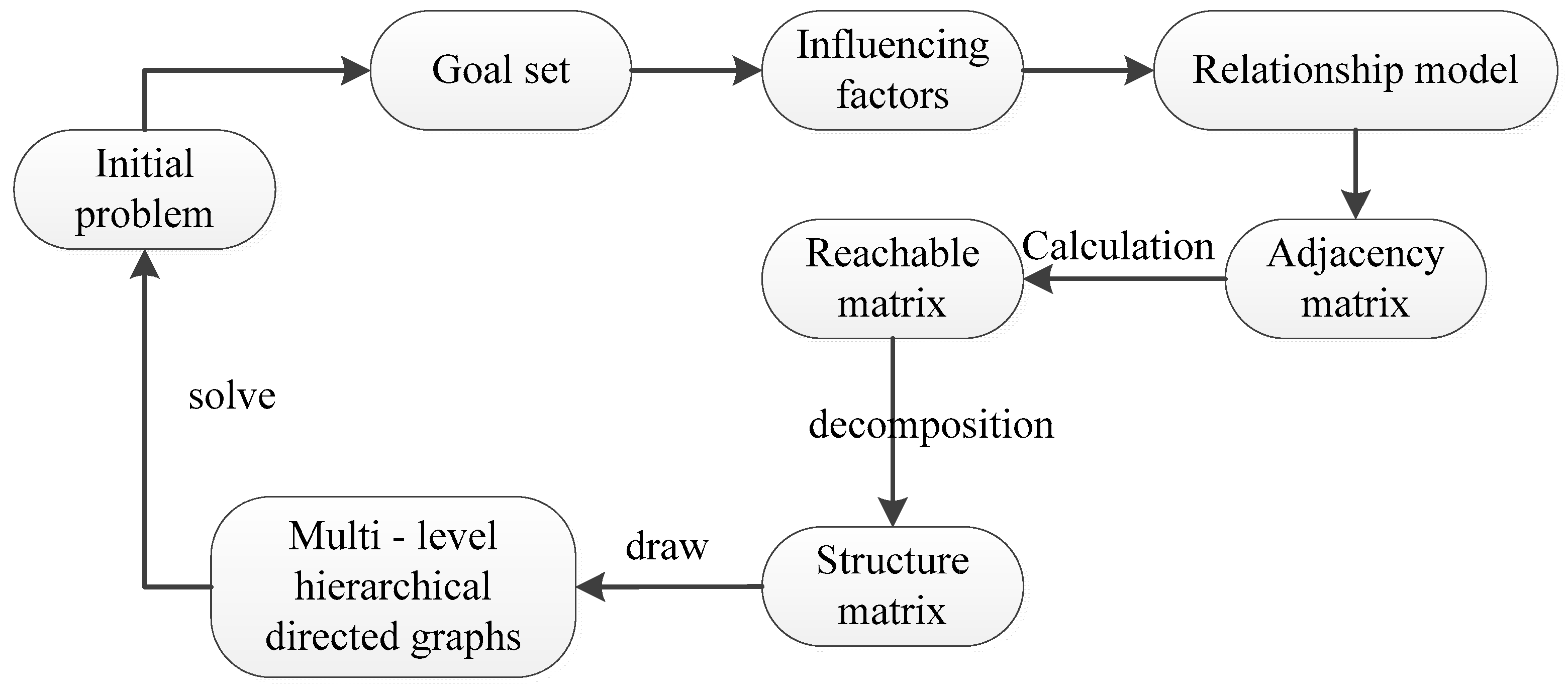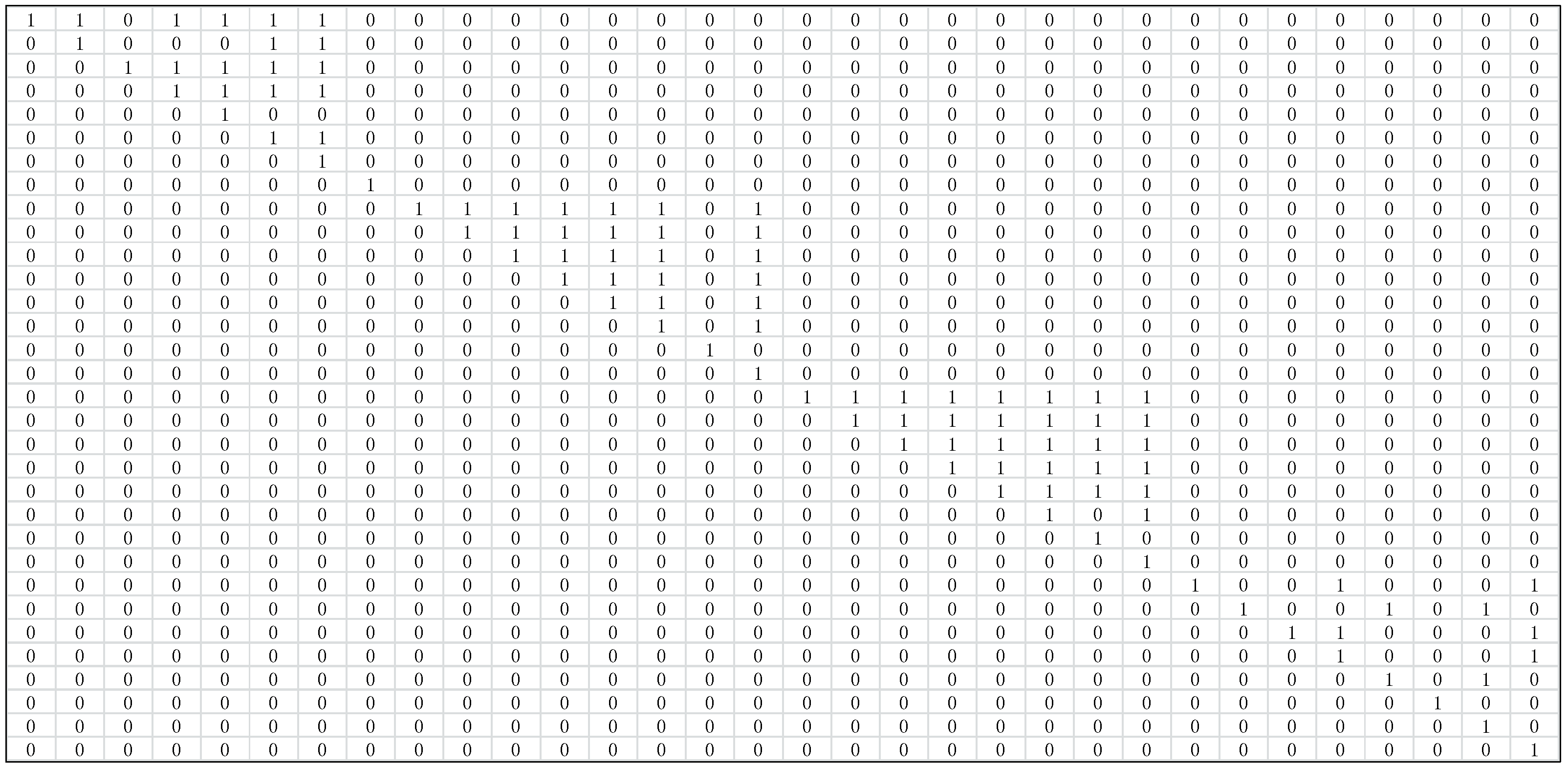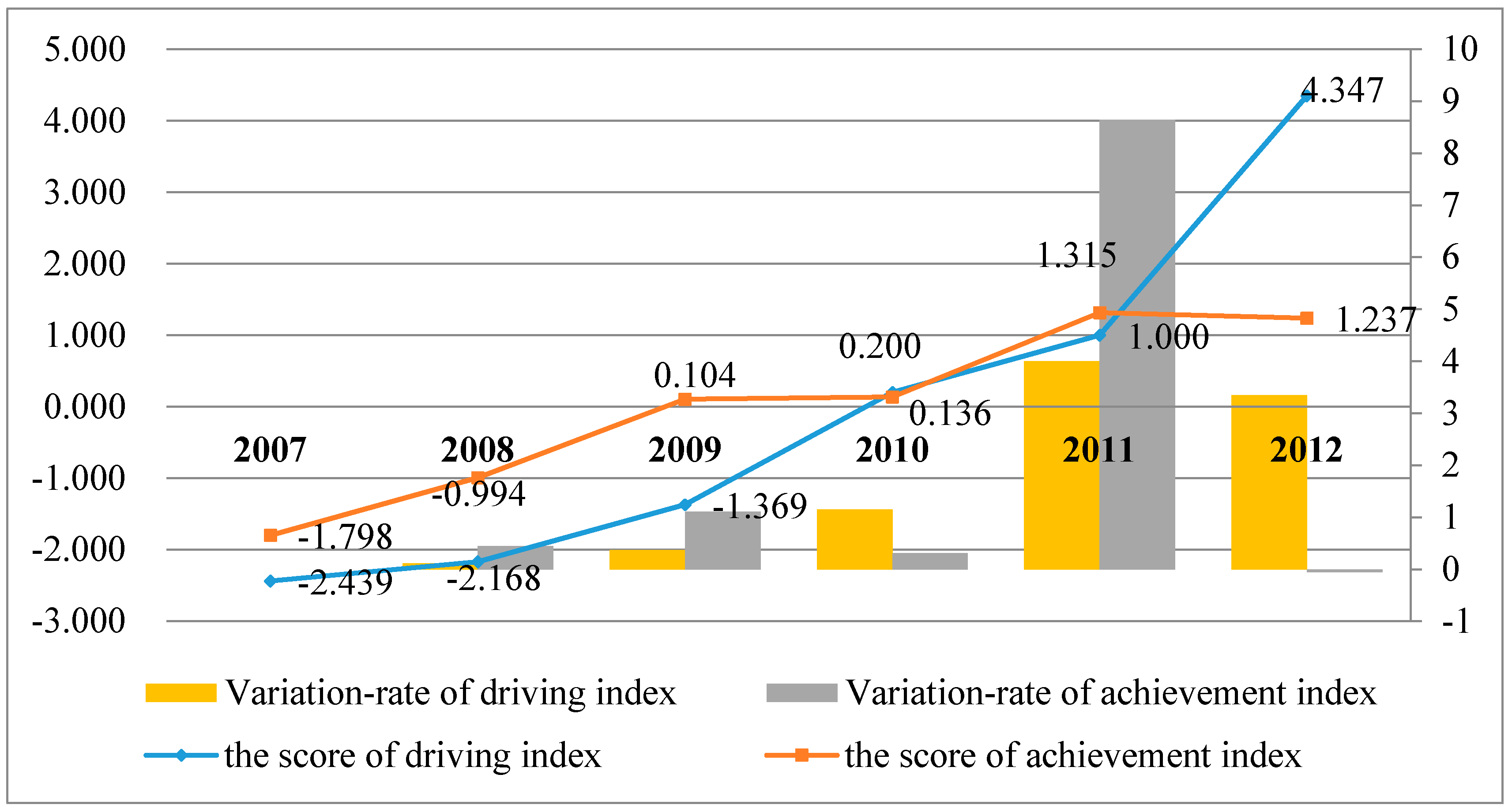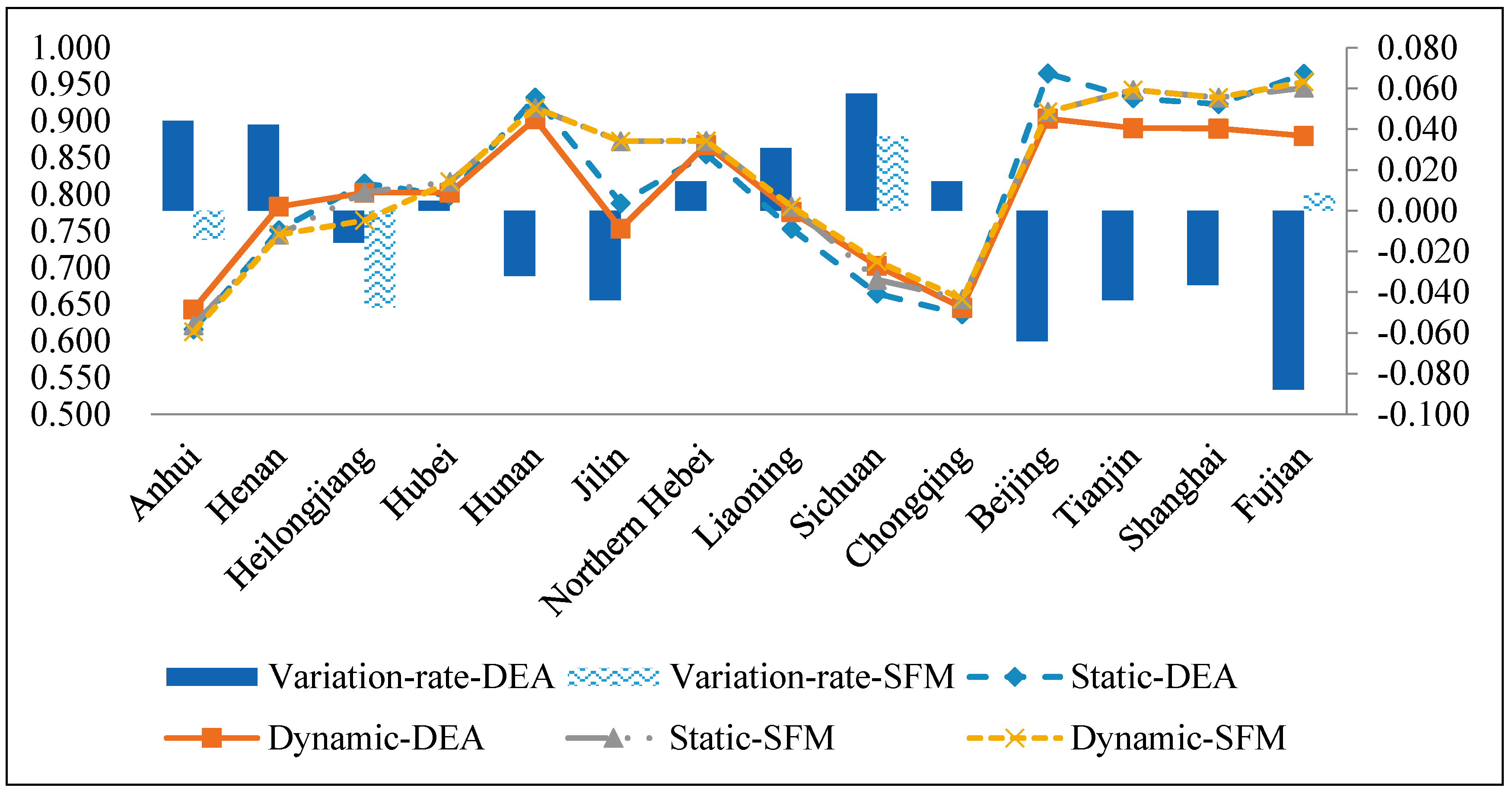3.1. Identification and Verification of Dual Index in Power Grid Enterprises
First, the index system was analyzed, and the element relation was constructed as per the relationship among indexes determined by expert grading. Next, an adjacency matrix was established based on this relationship (
Figure 2), and a reachability matrix was calculated through the matrix operation (
Figure 3).
Finally, the reachability matrix was decomposed under the condition of
, and the relation diagram was constructed based on the result (
Figure 1).
As seen in
Figure 4, the 32 indexes were distributed at two ends of the level, which meant that the element closer to the top was more likely to be affected, so had great dependence; and the element closer to the bottom was more likely to impact others, so had great driving force. Two core indicators were divided under different requirements: the achievement index group and the driving index group (specific indicators are shown in
Table 2).
The data was analyzed by SPSS, and to test whether 16 core indicators from the structural model could achieve a contribution rate of more than 85%. Based on the software results (
Table 3), the contribution rate was more than 85%, which meant that the extracted index by the structural model could represent the operational monitoring index of a power grid.
3.2. Operational Efficiency Evaluation of Power Grid Enterprises
(1) Driving index evaluation
We comprehensively evaluated eight driving indicators, and the results using SPSS software are shown in
Table 4.
Based on the processing results, we calculated the comprehensive evaluation model, as shown in the formula:
where
is comprehensive score; and
indicates the standard value of driving indicator
i.
(2) Achievement index evaluation
We also comprehensively evaluated eight achievement indicators, and the results using SPSS software are shown in
Table 5.
Based on the processing results, we calculated the comprehensive evaluation model shown in the formula:
where
is the comprehensive score; and
indicates the standard value of achievement indicator
i.
Based on the comprehensive evaluation model of the driving and achievement indexes, the index scores were calculated in combination with nearly six years of standard data. The trend chart is shown in
Figure 5.
From
Figure 5, the driving index of operational performance had a rising trend. Although the achievement index as basically the same, there were some differences, especially shown by the different trends in 2011 and 2012. This difference showed that the driving index was not only the influencing factor of the achievement index, but the most important one. Thus, the index analysis could be replaced by the driving and achievement indexes, which could greatly reduce the amount of computation and improve efficiency. Combined with the general trend and efficiency evaluation of the driving and achievement indexes, it could release an early warning signal and make recommendations.
3.3. Operational Efficiency Evaluation of Power Grid Enterprises
(1) Comparison of operating efficiency over the years
We used the driving index as the input index, and the achievement index as the output index. When considering the availability of the indicators, the output index was added, including the increased supply load of unit investment, the increased consumption of unit investment, and the transmission cost of unit quantity. Next, a company’s operational efficiency was analyzed and some improvements made based on the evaluation results.
First, actual data were collected from 2008 to 2013. The mixed distance function and bidirectional priority of input–output were used in the calculation. The result showed that annual efficiency evaluations were 1 from 2008 to 2013, and the scale returns were stable. Thus, the technical efficiency and scale benefit scores of this enterprise were 1, which meant it was well controlled in input–output proportion. At the same time, it also showed that input decision and post management were reasonable and had achieved good operating efficiency.
(2) Operational efficiency comparison among enterprises
As the contrast of operational efficiency can improve the investment decision, we selected 14 provincial companies to calculate their efficiency based on data from 2013. The mixed distance function and bidirectional priority of input–output were also selected, and the operation results are shown in
Table 6 and
Figure 6.
Where, DMU is abbreviation of Decision Making Unit; DEA is abbreviation of Data Envelopment Analysis; D-DEA is abbreviation of Dynamic Data Envelopment Analysis; SFM is abbreviation of Stochastic Frontier Model.
From
Table 6 and
Figure 6, we observed that the results were similar to the improved DEA and SFM methods when calculating technical efficiency over one year; therefore, the two improved methods could provide a good solution when the efficiency of the DMU was 1.
To better compare the two improved methods, we designed an efficiency linkage evaluation to account for many years, which considered the return delay of power grid investment. Through the technical efficiency calculation of each region, the results of the static efficiency and dynamic efficiency were compared, as shown in
Table 7 and
Figure 7.
From
Table 7 and
Figure 7, when considering the delay of grid investment, the dynamic and static evaluation results changed with the improved DEA method, and was relatively reasonable for the certain particularities of power grid investment, which include the large scale of fixed assets, long investment cycle, influence of grid structure, and regional economy. Therefore, it was not scientific to evaluate the static efficiency of power grid enterprises, and instead, dynamic efficiency evaluation should be adopted.
Results with a high efficiency declined and increased with low assessment results. Although there was more investment in a low assessment region in 2013, the income was not obvious, and the efficiency evaluation results were low. When considering the delay of investment benefit, the dynamic calculation obtained a higher evaluation efficiency.
Through the comparison of static and dynamic evaluation efficiency, the improved DEA model considered the impact of the previous year's investment on the operating result of the following year. Using Henan Province as an example, by comparing the static and dynamic efficiency evaluation of the two methods, the dynamic efficiency evaluation result improved with the modified DEA method that considered power grid structure and regional economic factors; the results of the dynamic efficiency evaluation did not change with the SFM model, which indicated that these factors were not taken into account. Therefore, the improved DEA model was more consistent with the factual data.












